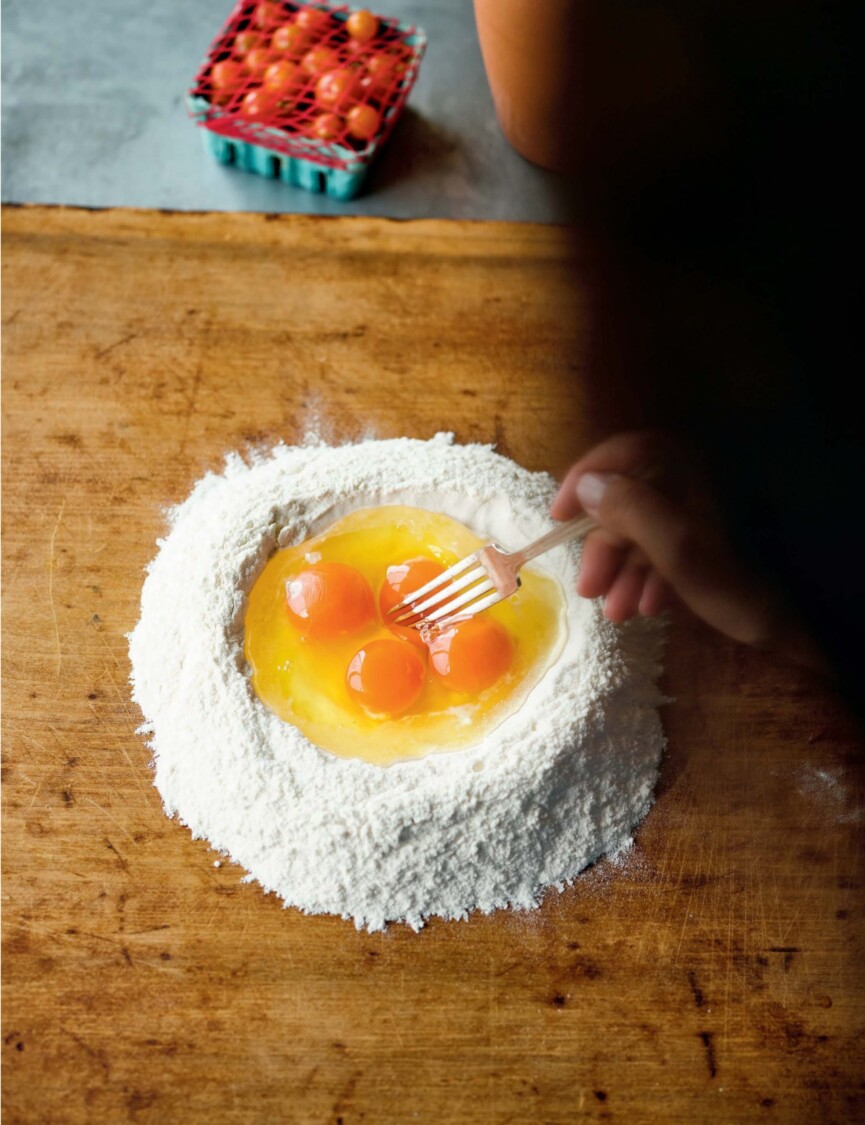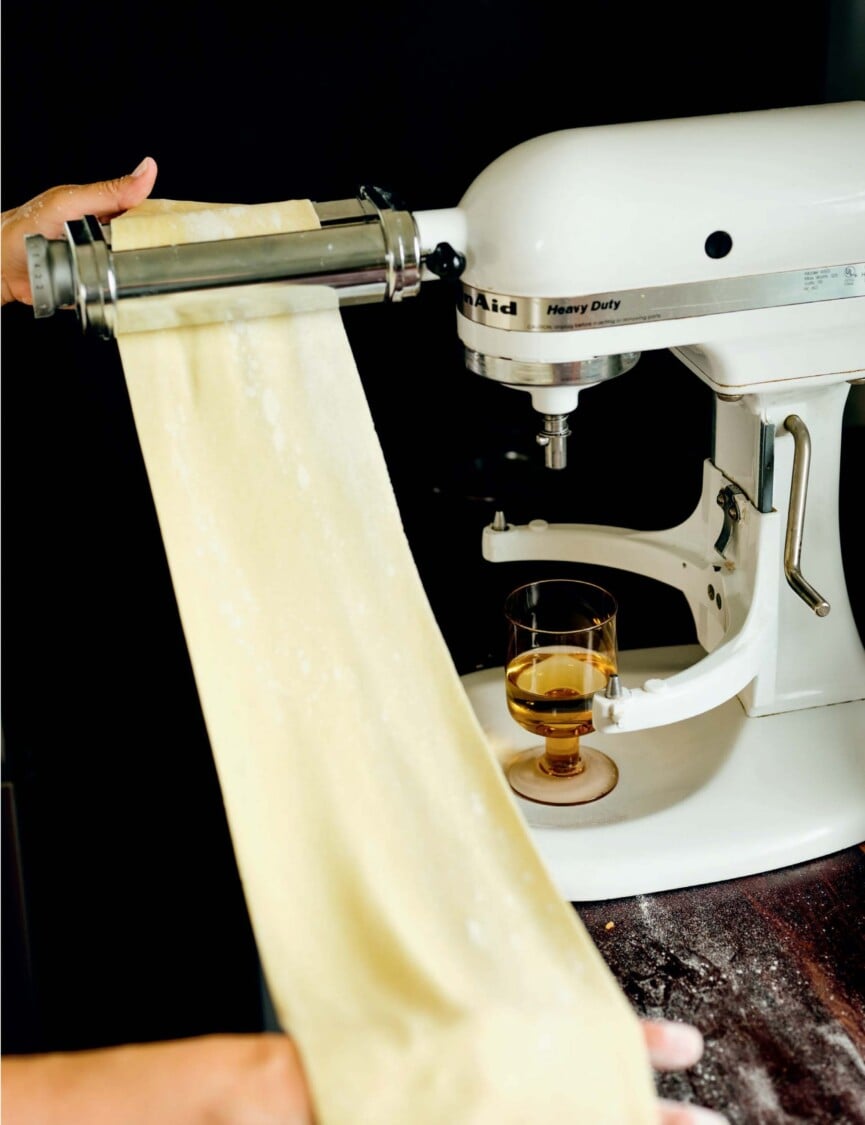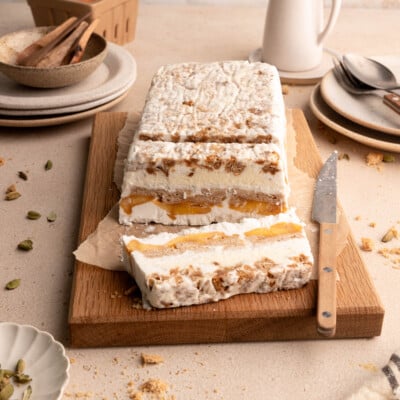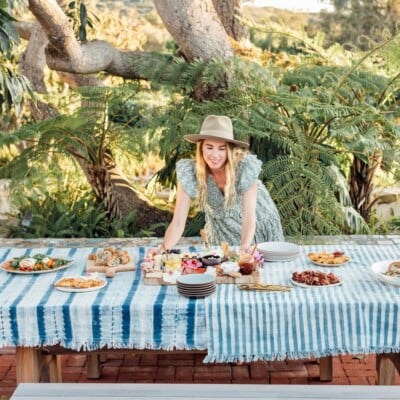When I first came across Odette Williams‘ book Simple Cake a few years ago, I instantly fell in love with the beautiful ode to simple ingredients that bring nostalgia and deliciousness to the forefront of every cake recipe in the book. Her latest, Simple Pasta, offers that same passion and love letter-like approach to the world of pasta.
One quick flip through the book and it’s easy to fall in love with the effortless elegance that Williams infuses in each recipe. Organized by the seasons, the book brings each part of the year to life through the world of pasta dinners that are anything but boring. And while I know the idea of making pasta from scratch might seem incredibly intimidating, Williams’ breaks down the step-by-step methods and tricks she’s learned along the way. Plus, nothing feels more gratifying than learning to make pasta from scratch… starting with her vegetable lasagna recipe below.
But before we get to the homemade goodness, I sat down with Williams to get her thoughts on all things cooking—tips to make from-scratch pasta less intimidating, the three recipes she thinks everyone should master, and what she loves most about creating and sharing recipes with the world.

What is your cooking philosophy and how has it influenced your new cookbook, Simple Pasta?
I’m all about keeping it simple. I’m Australian, and I think the Aussie, laid-back approach to cooking is very much my style. I don’t sweat it in the kitchen. I just want to cook and eat delicious food that makes you happy. Simple Pasta was such a joy to make, that I hope between the mood of the beautiful photography, and recipes, people get a great deal of pleasure from these pages.
Some people (like myself!) can feel intimidated by making pasta from scratch. What three tips would you share with someone who’s never made pasta at home?
I get it! I’d never made fresh pasta until I was forty (even though I had eaten it nearly every night of the week). Now I religiously make it. You are going to be amazed at just how simple it is.
- Give yourself time. Plan ahead. A lot of it can be made in advance. Try making it on the weekend, when you have time and can relax and enjoy the process.
- The first time you make the three doughs in the book, you’ll be getting a feel for them. The next time you make them, you’ll be off to the races.
- Call a friend, open a bottle of wine, and share the experience!

Tell us about this amazing vegetable lasagna recipe. Any tips our audience should know when making it?
It’s hard to top a meat lasagna, so I wanted a vegetable one that rose to the occasion. I slice the vegetables thinly and sauté them in oil, butter, and garlic so they get full of flavor. This way, the flavor-packed vegetables glide right in between the thin layers of pasta. No chunks! I also use vegetables that are available during the cooler months. The pesto packs in a lot of flavor and jazzes up the béchamel. You can also use store-bought if you want to cut a corner. But try Cavolo Nero, Parmiginao and Pistachio Pesto in winter. It’s delicious on any noodle.
The trick to lasagna is to give yourself plenty of time. So catch up on your podcasts while you prepare it. It’s going to get messy, and yes, there will be dishes, but you’ll be able to feed many! Or freeze some for a rainy day. For assembly, don’t sweat the layering, remember it’s just pasta. As long as you include all the elements, it’s going to be delicious!
Anything we can make ahead of time for the lasagna?
You can prepare all the vegetables, the béchamel, and pesto the day before. If using fresh pasta, that can be made the day of, or just use store-bought. But make the fresh stuff, it really makes a lasagna hum.
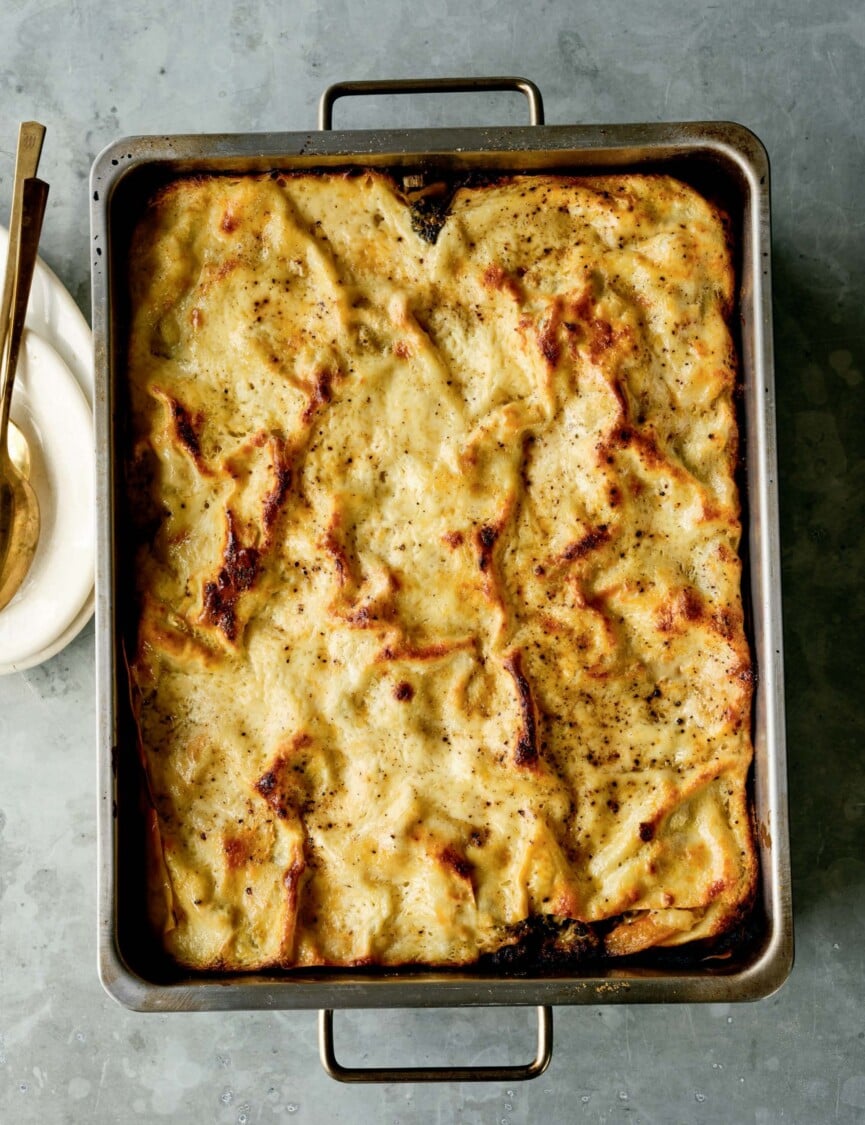
Which three recipes from the book should someone cook first?
Sophies Choice!!! Besides the Wicked, White Bolognese….
Potato Gnocchi with Luxurious Pomodoro, the Butter Lettuce with Celery, Pistachio & Pecorino Toscano is a great salad that goes with so many of the pastas, and the Peppery Pappardelle, Pancetta & Mushroom. That was painful to choose… can I squeeze in a fourth? Can’t cook without a cocktail, San Pellegrino 75!
What is your favorite part of creating recipes? What do you hope people experience or learn when they make one of your recipes?
Getting to eat pasta every day! I put a lot of work into the recipes and the curation of them, so you’ll find it simple to succeed when making them. These recipes have been put through their paces, they work, are approachable, and are bloody delicious. I can’t wait for folks to discover the Luxurious Pomodoro, Wicked White Bolognese, or just experience the difference of homemade gnocchi versus store-bought. I loved the way I was able to create seasonal menus so it’s not just about pasta. I love teaching people how to put a killer meal together. Cocktails, salads, deserts… they’re all there.
Keep scrolling to get Williams’ vegetable lasagna recipe from Simple Pasta.
Reprinted with permission from Simple Pasta by Odette Williams, copyright (c) 2022. Published by Ten Speed Press, a division of Penguin Random House, LLC.
Print
Damn That’s a Keeper Vegetable Lasagna
- Total Time: 1 hour 40 minutes
- Yield: 6–10 1x
Description
Your new favorite pasta recipe.
Ingredients
For the pasta:
- 3 cups/400g 00 flour, plus more for dusting
- 4 large eggs, at room temperature
- 2 teaspoons extra-virgin olive oil
- 1 pinch Kosher or fine sea salt
- Water, as needed
- If using store-bought pasta, use approximately 12 ounces dried lasagna sheets***
For the vegetable filling:
- 1 large butternut squash (about 3 pounds), peeled, seeded, and cut into 1/4 inch slices
- 1/2 cup extra-virgin olive oil, or as needed
- Kosher salt
- Freshly ground black pepper
- 8 tablespoons unsalted butter, or as needed
- 4 tablespoons water
- 6 garlic cloves
- 1 small cauliflower (about 1 1/4 pounds), cut into 1/4-inch slices
- 2 fennel bulbs (about 1 1/2 pounds total), thinly sliced
For the béchamel:
- 6 tablespoons unsalted butter
- 1/3 cup all-purpose flour
- 3 3/4 cups whole milk, warmed
- 6 sautéed garlic cloves (reserved from above)
- 1 cup finely grated Parmigiano-Reggiano
- 2 teaspoons kosher salt
- 1/8 teaspoon ground nutmeg
- Freshly ground white or black pepper
- 1 1/2 cups finely grated Parmigiano-Reggiano
- 1 cup Cavolo Nero, Parmigiano & Pistachio Pesto from Simple Pasta or store-bought basil pesto
- Freshly ground white or black pepper
- Basil leaves for finishing
- 3 tablespoons unsalted butter, cut into small pieces
- Flaky sea salt
Instructions
To make the pasta:
- To bring the dough together using a machine: In a stand mixer fitted with the paddle attachment, on low speed, combine the flour, eggs, olive oil, and salt and mix until crumbly.
- If using a food processor, pulse together the flour, eggs, olive oil, and salt until the dough starts coming together.
- Incrementally, add 1 teaspoon water at a time until the dough becomes a craggy ball and there are barely any dry crumbs of flour remaining. (Some days, it’s 3 teaspoons; other days, it’s a little more. Just don’t add too much water, since the flour will continue to hydrate as the dough is kneaded by hand.)
- Lightly flour a work surface, place the dough on the surface, and knead until it becomes a smooth and supple oval ball and springs back when lightly pressed, about 10 minutes. Remove the crease line in the dough by pinching the crease together and pushing down on it with your palm.
- Cover the ball of dough with plastic wrap, or turn a mixing bowl upside down and place it over the dough on the work surface, and let rest on the counter for 30 to 45 minutes. After resting, the dough may be sticky; if so, dust it with a little flour.
- If rolling pasta by machine: Divide the dough into four equal pieces. (If using a hand-cranked pasta roller, it is easier to work by dividing into six pieces.) Work with one piece at a time, keeping the remaining dough well covered in plastic wrap. Flatten the piece of dough between your palms before feeding it through the pasta machine once on the widest setting (#1).
- Still on the widest setting and at low speed, feed the dough through the pasta roller, then laminate it by folding it in thirds, just as you would fold a letter to fit into an envelope. Repeat this step a handful of times, turning the dough 90 degrees between each pass. Keep your folds tidy in order to create an even rectangular sheet.
- Now, feed the sheet of dough through the rollers, turning the knob down incrementally to a narrower setting between each pass (there’s no need to fold between passes anymore), until it’s rolled to the desired thickness. If the dough feels sticky or puckers as it’s rolled, sprinkle it lightly with flour and use your hand to spread it gently across the sheet before feeding it through the machine again. This helps to keep the dough flat and smooth and prevents it from getting stuck.
- Once the pasta is cut or filled, place on a flour-dusted baking sheet. Lightly dust a little more flour on top of the pasta so it doesn’t stick. (It’s completely okay if the pasta dries out at this stage.)
- If cooking within a couple of hours, simply leave on the counter. You can place stuffed pasta, uncovered, in the refrigerator for a few hours but be very careful that they don’t become a sticky mess.
- To store stuffed or cut pasta, freeze in a single layer on a baking sheet, transfer the frozen pasta to a ziplock bag or airtight container, and freeze for about 1 month. For longer pasta, like fettucine, make small individual portioned nests before freezing.
To prep the veggies:
- Preheat the oven to 350°F. Line two large baking sheets with parchment paper.
- Toss the squash in 1/4 cup of the olive oil, season with salt and pepper, and spread out evenly in a single layer on the prepared baking sheets.
- Scatter 2 tablespoons of the butter and 2 tablespoons of the water on each sheet, cover tightly with aluminum foil, and cook until softened, about 15 minutes, then remove from the oven. Set aside.
- While the squash is cooking, in a large frying pan over medium-high heat, warm 2 tablespoons butter and 2 tablespoons olive oil with 3 garlic cloves.
- Working in batches if needed, add the cauliflower, season with a little salt, and sauté, basting with the garlic-infused butter. Try not to break up the delicate slices (adding more butter and olive oil as needed). Cook until tender, about 15 minutes. Remove everything from the pan and set aside.
- Add the remaining 2 tablespoons butter, remaining 2 tablespoons olive oil, and remaining 3 garlic cloves to the same pan. Working in batches if needed, add the fennel and season with a little salt. Sauté until soft and caramelized, 15 to 20 minutes (adding more butter and oil as needed).
- Turn off the heat and remove all the garlic from both the fennel and cauliflower. Finely chop the garlic and set aside.
To make the béchamel:
- In a large heavy-bottomed saucepan over low heat, melt the butter. Add the flour and cook for 2 minutes while constantly whisking. Gradually whisk in the milk, until smooth.
- When the béchamel has the consistency of heavy cream, whisk in the chopped garlic, Parmigiano, salt, nutmeg, and some cranks of pepper to combine.
- Bring a large pot of lightly salted water to a boil. Working in batches, add four sheets of pasta at a time and blanch just until softened, 1 to 2 minutes, or cook for 7 to 8 minutes or according to package instructions if using store-bought.
- Using a large spider, remove the sheets and lay them out on a clean surface. (Careful, they’ll be hot!)
- When cool enough to touch, unfurl the sheets and splash a little olive oil over them to keep them from sticking. Repeat with the remaining pasta sheets.
To assemble:
- Preheat the oven to 400°F.
- Butter a deep 9 by 13-inch baking dish, spread a thin layer of béchamel over the bottom, cover with a layer of pasta, then add a layer of squash.
- Sprinkle some of the fennel and Parmigiano on top, dot with a little pesto, and season with pepper.
- Cover with another layer of pasta, béchamel, and now cauliflower. Sprinkle more fennel and Parmigiano on top and add a little more pesto and pepper.
- Finish with a layer of squash, since you’ll still have some left, then a final layer of pasta, béchamel, Parmigiano, and basil. Scatter the butter pieces on top.
- Bake the lasagna until the top is golden and the edges are crisp, about 30 minutes. Let it rest and compose itself for about 10 minutes and sprinkle with sea salt just before serving.
- Prep Time: 60
- Cook Time: 40


